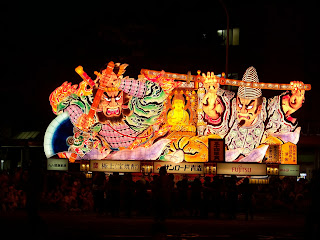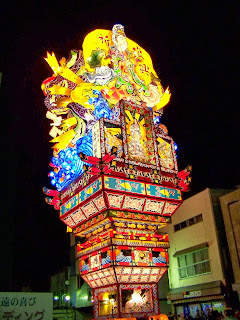After gathering everyone from different pickup points, we set foot on an apple farm in Hirakawa City, a small city half an hour east of Hirosaki and about an hour southwest of Aomori City. We were basically told: "You can all pick 3. The ones that are yellow are delicious. Go!" We all looked at each other uneasily before asking how to pick them and what kind of apples they were.
The kinds of apples we picked were yellow-skinned Toki apples. Compared to your standard Fuji apple (which the farm grows as well), Toki apples have less wholesome juiciness and more sugary sweetness. We wandered through the groves looking for big apples to pick. They told us not to pull the apples, and that the correct way to pick an apple is to bend the stem and snap it with leverage.
 |
| What a beautiful apple... |
 |
| Honeybunny doing the deed |
 |
| Showing off our haul in front of Mt. Iwaki |
 |
| The hotel is rather new, so everything was shiny and gorgeous. |
Our purpose for visiting Apple Land was for opinion exchange to help improve their operations for foreign visitors. They wanted us to rate the taste of the food and give feedback for the facilities offered by the hotel. I chuckled a little watching them try very hard at little things like interior decoration and food selection when they didn't even have an English speaker. It seems a bit naive to think those things would make a difference if they cant assist people who don't speak Japanese. After all, only a very small percentage of foreigners can actually communicate in Japanese. I brushed that thought aside and just did what they asked.
The food itself was pretty standard. The kaisendon, topped with salmon, tuna, amberjack, bream, and salmon eggs, was tasty but small, and it paled in comparison with the fresh fish you can find at Nokkedon. We also had to remind the coordinator that many foreigners are still uncomfortable eating raw fish or meat, so having and alternative would be a good idea. The tsugarusoba was the most mediocre of all and seemed like something you could find in any noodle shop. My favorite thing in the meal was the bamboo shoots in goma sesame seed sauce because the bamboo was soft and supple like I've never tasted (and I'm a huge sucker for goma).
After food, the main coordinator lead us around the entire hotel site, which is large and has many different venues to offer. They showed us the hotel rooms, which were VERY nice (and, I can imagine, expensive), as well as the main buffet and main events hall. They pointed out the window of the 5th floor and showed us a massive female Buddhist figure perched on the roof, holding an apple above her head. The coordinator explained that they were trying to make a "power spot" there to attract visitors, and I couldn't help but scoff at the blasphemy of it all.
Finally, we headed down to the ground floor and went to the bathing areas. Here, they have some very famous apple onsen baths. Inside the baths, hundreds of apples float around in the hot water and release a nice light fruity fragrance. It's a little unnerving to willing hop into fruity water, and I couldn't help but think of it as a waste of fruit, but many people really enjoy the experience. Unfortunately for us, because of time constraints and the fact that the baths were particularly crowded that day, we had to skip the main baths. We only had the opportunity to go to the foot-bath outside.
 |
| Entrance to the apple baths |
 |
| The outdoor apple foot-bath |
When we were done, they told us we could just eat the apple since we didn't have time to boil the apples anyways. The provided us with slices of apple that were already prepared to be put in the pie, and we enjoyed the delicious Fuji apple after cutting it on a plate. Well, at least we thought it was a plate, but it turned out to be the frozen pastry sheet we would use for the pie. Actually, it was much closer to an apple tart than an apple pie, but let's not try to confuse the Japanese people, shall we?
We cut the sheet in half, stabbed hundreds of holes in the bottom sheet, laid apple slices on top of that, and sealed the sheets shut with a fork. Then, we got to decorate the top of the tart with the discard strips of pastry.
 |
| Laying on the apple |
 |
| Decorating finished! |
 |
| Tada! 出来上がり! |
Anyways, that's the end for this time! Thanks for reading, and see you again!








